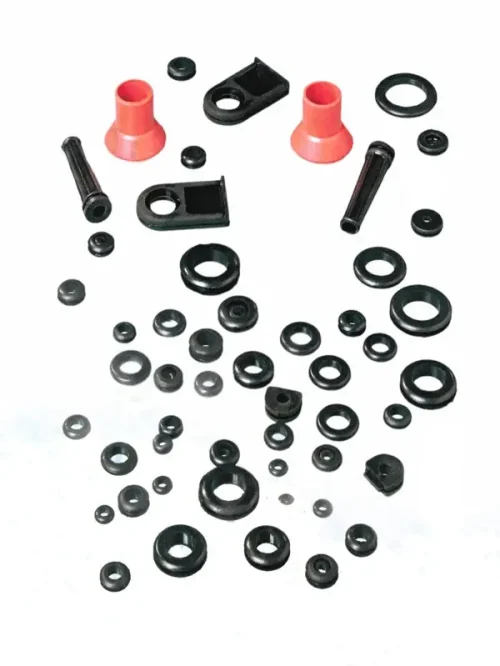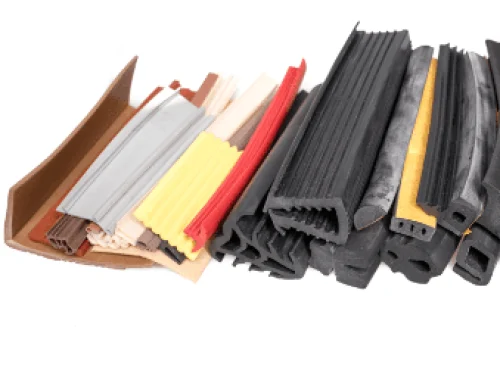Rubber sleeves, plugs, couplings, caps
Sleeves refer to any covering or covering for an object, usually long and cylindrical in shape.
Shock absorbers are mechanical devices designed to smooth out or dampen impact impulses, vibrations or oscillations in machines or structures.
Legs are additional parts that are used for support and movement in the furniture industry, structures and other industries.
Cuffs are among the most important types of seals for moving parts of hydraulic and pneumatic equipment for rectilinear sliding movement. They are also used in other industries.
Rubber bumpers – produced in forms or in thick profiles. Suitable for transport ramps or walls in warehouses, harbors as protection when boarding.
Small sizes are also available, e.g. for doors, cranes or other technical equipment.
Learn More

PRODUCT DESCRIPTION
Description and use
Shock absorbers: Absorption of shocks, vibrations and oscillations
Shock absorbers are mechanical devices designed to reduce or dampen shocks, vibrations or oscillations in machines or structures. They are essential components in a wide range of applications, from cars and motorcycles to industrial machines and even sports equipment. They are produced in forms or in rough profiles. Suitable for transport ramps or walls in warehouses, ports as protection when boarding. By absorbing and dissipating energy shocks and vibrations shock absorbers help to ensure smooth and stable operation of machines and vehicles. This not only provides a more comfortable experience for the user, but also helps extend the life of the device and prevent damage and wear.
Legs are additional seals for support and movement, used to support and move animals or to support furniture and structures. In animals, legs are essential for movement, as they allow them to move from place to place and perform various tasks. In furniture and structures, legs provide stability and support. They can also have a decorative character as they add style and design to tables, chairs and other objects.
Cuffs are among the most important types of seals for moving parts. They are used for various purposes, e.g. covering pistons and ball screws. They are suitable for protecting linear drives from dust, grinding sludge, coolant or oil.
Properties
Performances
Material basis
Technical documentation
Downloads:
Description and use
Description and use – profiles for the construction industry represent the largest group of produced profiles. They are frequently used as concrete profiles, construction – dilated profiles (profiles for plasterboard, insulation), sealing profiles, profiles for shower baths, glazing profiles, profiles for residential containers, as well as in households, gardening, furniture, and various other industries (sports lines, clay courts, sliding track rails, connecting components, reinforcements, covers)
Properties
Properties – profiles made of softened PVC are resistant to standard weather conditions and temperatures from -30 °C to + 70 °C without changing the performance properties, however, with prolonged sun exposure, there is a slow aging process.
Performances
Design – they are produced in several basic shapes, such as square, rectangle, circular gasket, intermediate ring, and various specific shapes. Profiles can also be made as self-adhesive, colored according to the RAL scale, transparent.
Material basis
Material basis – various types of PVC granulate with a specific weight of 1.2 -1.5 g / cm3 and a hardness range from 40 to 90 °ShD are used in the production. The properties of the individual granules vary depending on the manufacturer.
Technical documentation
SAMPLES OF PROFILES
Plastic profiles (PVC, uPVC)

PRODUCT DESCRIPTION
Description and use
Description and use – profiles for the construction industry represent the largest group of produced profiles. They are frequently used as concrete profiles, construction – dilated profiles (profiles for plasterboard, insulation), sealing profiles, profiles for shower baths, glazing profiles, profiles for residential containers, as well as in households, gardening, furniture, and various other industries (sports lines, clay courts, sliding track rails, connecting components, reinforcements, covers)
Properties
Properties – profiles made of softened PVC are resistant to standard weather conditions and temperatures from -30 °C to + 70 °C without changing the performance properties, however, with prolonged sun exposure, there is a slow aging process.
Performances
Design – they are produced in several basic shapes, such as square, rectangle, circular gasket, intermediate ring, and various specific shapes. Profiles can also be made as self-adhesive, colored according to the RAL scale, transparent.
Material basis
Material basis – various types of PVC granulate with a specific weight of 1.2 -1.5 g / cm3 and a hardness range from 40 to 90 °ShD are used in the production. The properties of the individual granules vary depending on the manufacturer.
Technical documentation
Description and use
Description and use – profiles for the construction industry represent the largest group of produced profiles. They are frequently used as concrete profiles, construction – dilated profiles (profiles for plasterboard, insulation), sealing profiles, profiles for shower baths, glazing profiles, profiles for residential containers, as well as in households, gardening, furniture, and various other industries (sports lines, clay courts, sliding track rails, connecting components, reinforcements, covers)
Properties
Properties – profiles made of softened PVC are resistant to standard weather conditions and temperatures from -30 °C to + 70 °C without changing the performance properties, however, with prolonged sun exposure, there is a slow aging process.
Performances
Design – they are produced in several basic shapes, such as square, rectangle, circular gasket, intermediate ring, and various specific shapes. Profiles can also be made as self-adhesive, colored according to the RAL scale, transparent.
Material basis
Material basis – various types of PVC granulate with a specific weight of 1.2 -1.5 g / cm3 and a hardness range from 40 to 90 °ShD are used in the production. The properties of the individual granules vary depending on the manufacturer.





